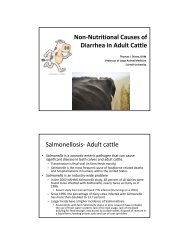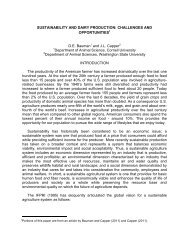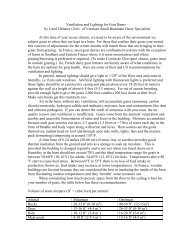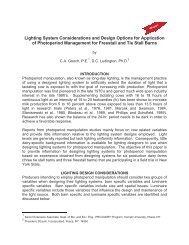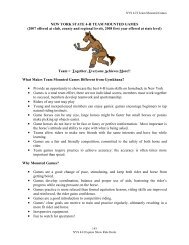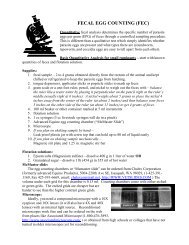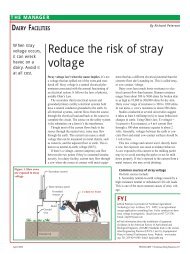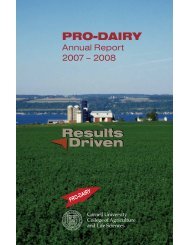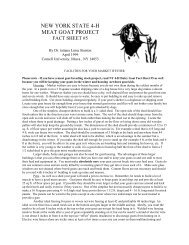2009 Proceedings of the Cornell Nutrition Conference For Feed ...
2009 Proceedings of the Cornell Nutrition Conference For Feed ...
2009 Proceedings of the Cornell Nutrition Conference For Feed ...
You also want an ePaper? Increase the reach of your titles
YUMPU automatically turns print PDFs into web optimized ePapers that Google loves.
MAXIMIZING MILK COMPONENTS AND METABOLIZABLE PROTEIN UTILIZATION<br />
THROUGH AMINO ACID FORMULATION<br />
C.G. Schwab 1 and G.N. Foster 2<br />
1 Department <strong>of</strong> Biological Sciences<br />
University <strong>of</strong> New Hampshire<br />
and<br />
2 Central Valley <strong>Nutrition</strong>al Associates, LLC<br />
Tulare County, California<br />
Heger and Frydrych (1989) concluded, largely from research with non-ruminant<br />
animals, that when <strong>the</strong> essential amino acids (EAA) are absorbed in <strong>the</strong> pr<strong>of</strong>ile as<br />
required by <strong>the</strong> animal, <strong>the</strong> requirements for total EAA is reduced and <strong>the</strong>ir efficiency <strong>of</strong><br />
use for protein syn<strong>the</strong>sis is maximized. Research with lactating dairy cows has been<br />
shown many times that increasing predicted concentrations <strong>of</strong> Lys and Met in<br />
metabolizable protein (MP) to recommended levels increases efficiency <strong>of</strong> use <strong>of</strong> MP for<br />
milk protein syn<strong>the</strong>sis. This should not be a surprising observation in feeding situations<br />
where Lys and Met are <strong>the</strong> first two limiting AA. Therefore, it is reasonable to conclude<br />
that maximizing milk components and MP utilization in lactating dairy cows requires<br />
providing a pr<strong>of</strong>ile <strong>of</strong> AA in MP that matches <strong>the</strong> pr<strong>of</strong>ile required for <strong>the</strong> combined<br />
functions <strong>of</strong> maintenance, reproduction, and milk production, and that <strong>the</strong> MP is<br />
provided in amounts that meets but doesn’t exceed requirements for optimal health,<br />
reproduction and milk production.<br />
Research to date indicates that <strong>of</strong> <strong>the</strong> twenty AA that occur in proteins, only <strong>the</strong><br />
amount and pr<strong>of</strong>ile <strong>of</strong> EAA in MP are <strong>of</strong> concern. Providing a mixture <strong>of</strong> nonessential<br />
AA (NEAA) to post-weaned dairy calves (Schwab et al., 1982), or lactating dairy cows<br />
(Oldham et al., 1979; Schwab et al., 1976; Whyte et al., 2006), where one or more EAA<br />
were shown to be limiting, were without benefit. It was also observed that infusing <strong>the</strong><br />
10 EAA into <strong>the</strong> abomasum <strong>of</strong> lactating cows fed protein deficient diets resulted in<br />
increases in yields <strong>of</strong> milk protein that were similar to <strong>the</strong> yields that were obtained<br />
when casein was infused. Collectively, <strong>the</strong>se observations indicate that when AA<br />
supplies approach requirements for total absorbable AA, requirements for total NEAA<br />
are met before <strong>the</strong> requirements for <strong>the</strong> most limiting EAA.<br />
In recognition <strong>of</strong> <strong>the</strong>se observations, and because Lys and Met had been shown to<br />
be <strong>the</strong> first two limiting EAA for lactating dairy cows fed diets common to North America,<br />
NRC (2001) published dose-response plots that related changes in measured<br />
percentages and yields <strong>of</strong> milk protein to model-predicted changes in Lys and Met<br />
concentrations in MP. By using a rectilinear model to describe <strong>the</strong> dose-response<br />
relationships, breakpoint estimates for <strong>the</strong> required concentrations <strong>of</strong> Lys and Met in MP<br />
for maximal content <strong>of</strong> milk protein were determined to be 7.2 and 2.4%, respectively;<br />
corresponding values for maximal protein yield were 7.1 and 2.4%. These were <strong>the</strong> first<br />
estimates ever presented by a Dairy NRC Committee to evaluate a diet for adequacy <strong>of</strong><br />
AA concentrations in MP, and have proven exceptionally useful for routine users <strong>of</strong> <strong>the</strong><br />
NRC (2001) model in <strong>the</strong>ir quest to increase milk component yields with similar or lower<br />
1



